Mediterranean Squadron (United States)
| Mediterranean Squadron | |
|---|---|
 USS Enterprise of the Mediterranean Squadron capturing the polacca Tripoli during the First Barbary War. | |
| Active | 1801–1865 |
| Country | |
| Branch | |
| Type | Naval squadron |
| Garrison/HQ | Mahón (1815–1840) |
The Mediterranean Squadron, also known as the Mediterranean Station, was part of the United States Navy in the 19th century that operated in the Mediterranean Sea. It was formed in response to the First and Second Barbary Wars. Between 1801 and 1818, the squadron was composed of a series of rotating squadrons. Later, squadrons were sent in the 1820s to the 1860s to suppress piracy, primarily in Greece and to engage in gunboat diplomacy.[1] In 1865 the force was renamed the European Squadron.
History
First Barbary War
The

As attacks on merchantmen continued, the United States government eventually authorized the United States Navy to send a second squadron to blockade Tripoli and attack their ships. In May 1802 Captain
At the final
Second Barbary War
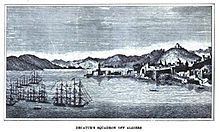
The Mediterranean Squadron continued to operate until 1807. That year the squadron was withdrawn which tempted the Barbary corsairs to attack American ships again. It was not until the end of the
Ships of the Squadron
First Squadron
Commanded by Commodore Richard Dale. Deployed in 1801, and returned to the United States in 1802.[1]
| Name | Type | Guns | Captain |
|---|---|---|---|
| Boston [1] | 2nd class frigate | 28 guns [1] | Daniel McNeill[1] |
| Enterprise [1] | Schooner | 12 guns [1] | Andrew Sterett[1] |
| Essex [1] | 2nd class frigate | 32 guns [1] | William Bainbridge[1] |
| George Washington [1] | Sloop of war |
24 guns [1] | John Shaw[1]
|
| Philadelphia [1] | 2nd class frigate | 36 guns [1] | Samuel Barron[1] |
| President [1] | 1st class frigate | 44 guns [1] | James Barron[1] |
Second Squadron
Commanded by
| Name | Type | Guns | Captain |
|---|---|---|---|
| Adams [1] | 2nd class frigate | 28 guns [1] | Hugh Campbell[1] |
| Boston [1] | 2nd class frigate | 28 guns [1] | Daniel McNeill[1] |
| Chesapeake [1] | 2nd class frigate | 36 guns [1] | Isaac Chauncey,[1] James Barron[1] |
| Constellation [1] | 2nd class frigate | 36 guns [1] | Alexander Murray[1] |
| Enterprise [1] | Schooner | 12 guns [1] | Andrew Sterett,[1] Isaac Hull[1] |
| George Washington [1] | Sloop of war |
24 guns [1] | John Shaw[1]
|
| John Adams [1] | 2nd class frigate | 28 guns [1] | John Rodgers[1]
|
| New York [1] | 2nd class frigate | 36 guns [1] | James Barron,[1] Isaac Chauncey[1] |
Third Squadron
Commanded by Commodore Edward Preble.[1] Deployed in 1803, and returned to the United States in 1804.[1]
| Name | Type | Guns | Captain |
|---|---|---|---|
| Argus [1] | Brig | 16 guns [1] | Isaac Hull[1] |
| Constitution [1] | 1st class frigate | 44 guns [1] | John Dent,[1] Thomas Robinson[1]
(Lieutenants acting as flag captain to Commodore Preble) [1] |
| Enterprise [1] | Schooner | 12 guns [1] | Stephen Decatur[1] |
| Intrepid [1] | Ketch | 4 guns [1] | Stephen Decatur,[1] Richard Somers[2] |
| John Adams [1] | 2nd class frigate | 28 guns [1] | Isaac Chauncey[1] |
| Nautilus [1] | Schooner | 12 guns [1] | Richard Somers,[1] John Dent[1] |
| Philadelphia [1] | 2nd class frigate | 36 guns [1] | William Bainbridge[1] |
| Scourge [1] | Brig | 16 guns [1] | Ralph Izard[1]
|
| Syren [1] | Brig | 16 guns [1] | Charles Stewart[1]
|
| Vixen [1] | Schooner | 12 guns [1] | John Smith[1] |
| N/a | two bomb-vessels[3] | ||
| N/a | nine gunboats[3] |
In 1843, the squadron comprised four ships, Columbia, Cumberland, Fairfield and Plymouth.
Commanders
| Name | Picture | Rank | Assigned (Orders) |
Assumed (On Station) |
Relieved (Orders) |
Relieved (On Station) | |
|---|---|---|---|---|---|---|---|
| 1 | COM Richard Dale[4] (First Squadron) [2] |
May 20, 1801 [2] | July 1, 1801 [5] | ? | ? | ||
| 2 | COM Richard Morris[4] (Second Squadron) [2] |
? | May 25, 1802 [6] | June 21, 1803 [2] | September 11, 1803 [2] | ||
| 3 | 
|
June 21, 1803 [2] | September 11, 1803 [6] | ? | ? | ||
| 4 | COM Edward Preble[4] (Third Squadron) [2] |
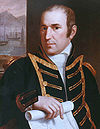
|
May 19, 1803 [4] | September, 1803 [5] | 1804 [4] | ? | |
| 5 | April, 1804 [6] | September 10, 1804 [6] | May 22, 1805 [6] | May 24, 1805 [6] | |||
| 6 | 
|
May 22, 1805 [6] | May 24, 1805 [6] | ? | May 27, 1806 [6] | ||
| 7 | COM Hugh Campbell[6] (Fourth Squadron) [6] |
? | May 27, 1806 [6] | ? | ? | ||
| COM Stephen Decatur[6] | 
|
? | June 14, 1815 [7] | 1815 [7] | 1815 [7] | ||
| COM William Bainbridge[7] | 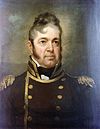
|
1815 [7] | ? | ? | 6 oct 1815 [8] | ||
John Shaw[7]
|
? | 6 oct 1815 [8] | ? | ? | |||
| COM Isaac Chauncey | 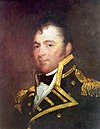
|
? | 1816 [9] | ? | February 1, 1818 [10] | ||
Charles Stewart[10]
|
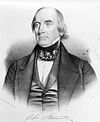
|
? | February 1, 1818 [10] | ? | 1820 | ||
| COM William Bainbridge[7] | 
|
? | ? | ? | June 4, 1821 [8] | ||
| COM Jacob Jones[8] | 
|
? | June 4, 1821 [8] | ? | 1823 [11] | ||
| COM John Creigton[6] | 
|
? | ? | ? | 1824 [12] | ||
Thomas MacDonough[6]
|

|
? | Nov 24, 1824 [12] | ? | Apr 30, 1825 [12] | ||
John Rodgers[6]
|

|
? | April 30, 1825 [6] | ? | May 31, 1827 [6] | ||
| COM William Crane[13] | ? | 1827 [13] | ? | ? |
- Daniel Patterson 1832–1836
- Jesse D. Elliott1836–1838
- Isaac Hull 1838–1841
- Joseph Smith 1843
- William Bolton 1848
- Charles W. Morgan 1850
- Samuel Livingston Breese 1856–1859
- Uriah Phillips Levy1860
References
- ^ a b c d e f g h i j k l m n o p q r s t u v w x y z aa ab ac ad ae af ag ah ai aj ak al am an ao ap aq ar as at au av aw ax ay az ba bb bc bd be bf bg bh bi bj bk bl bm bn bo bp bq br bs bt bu bv bw bx by bz ca cb cc cd ce cf cg Allen, Gardner Weld (1905). Our Navy and the Barbary Corsairs. Chester: Houghton Mifflin.
- ^ ISBN 978-1-55750-583-5.
- ^ OCLC 61122130.
- ^ OCLC 6707539.
- ^ ISBN 978-1-55750-984-0.
- ^ Charles, Charles Oscar(1910). Commodore John Rodgers, Captain, Commodore, and Senior Officer of the American Navy, 1773–1838. The Arthur H. Clark Company.
- ^ a b c d e f g Waldo, S. Putnam (1822). The Life and Character of Stephen Decatur; Late Commodore and Post-Captain in the Navy of the United States, and Navy-Commissioner. Clarke & Lyman.
- ^ a b c d e Harris, Thomas (1837). The Life and Services of Commodore William Bainbridge, United States Navy. Carey Lee & Blanchard.
- ^ United States Navy Historical Center. "US People--Chauncey, Isaac, Commodore, USN". Retrieved 9 March 2010.
- ^ a b c This article incorporates text from the public domain Dictionary of American Naval Fighting Ships.
- ^ United States Navy Historical Center. "US People--Jones, Jacob (1768–1850)". Retrieved 9 March 2010.
- ^ a b c MacDonough, Rodney (1909). Life of Commodore Thomas MacDonough, United States Navy. The Fort Hill Press.
- ^ a b Ripley, George; Dana, Charles A. (1869). New American Cyclopaedia. D. Appleton and Company.
Further reading
- London, Joshua E.Victory in Tripoli: How America's War with the Barbary Pirates Established the U.S. Navy and Shaped a Nation New Jersey: John Wiley & Sons, Inc., 2005.
